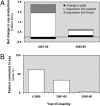Decoupling of deforestation and soy production in the southern Amazon during the late 2000s
- PMID: 22232692
- PMCID: PMC3268292
- DOI: 10.1073/pnas.1111374109
Decoupling of deforestation and soy production in the southern Amazon during the late 2000s
Abstract
From 2006 to 2010, deforestation in the Amazon frontier state of Mato Grosso decreased to 30% of its historical average (1996-2005) whereas agricultural production reached an all-time high. This study combines satellite data with government deforestation and production statistics to assess land-use transitions and potential market and policy drivers associated with these trends. In the forested region of the state, increased soy production from 2001 to 2005 was entirely due to cropland expansion into previously cleared pasture areas (74%) or forests (26%). From 2006 to 2010, 78% of production increases were due to expansion (22% to yield increases), with 91% on previously cleared land. Cropland expansion fell from 10 to 2% of deforestation between the two periods, with pasture expansion accounting for most remaining deforestation. Declining deforestation coincided with a collapse of commodity markets and implementation of policy measures to reduce deforestation. Soybean profitability has since increased to pre-2006 levels whereas deforestation continued to decline, suggesting that antideforestation measures may have influenced the agricultural sector. We found little evidence of direct leakage of soy expansion into cerrado in Mato Grosso during the late 2000s, although indirect land-use changes and leakage to more distant regions are possible. This study provides evidence that reduced deforestation and increased agricultural production can occur simultaneously in tropical forest frontiers, provided that land is available and policies promote the efficient use of already-cleared lands (intensification) while restricting deforestation. It remains uncertain whether government- and industry-led policies can contain deforestation if future market conditions favor another boom in agricultural expansion.
Conflict of interest statement
The authors declare no conflict of interest.
Figures




Similar articles
-
Soy moratorium impacts on soybean and deforestation dynamics in Mato Grosso, Brazil.PLoS One. 2017 Apr 28;12(4):e0176168. doi: 10.1371/journal.pone.0176168. eCollection 2017. PLoS One. 2017. PMID: 28453521 Free PMC article.
-
Cropland expansion changes deforestation dynamics in the southern Brazilian Amazon.Proc Natl Acad Sci U S A. 2006 Sep 26;103(39):14637-41. doi: 10.1073/pnas.0606377103. Epub 2006 Sep 14. Proc Natl Acad Sci U S A. 2006. PMID: 16973742 Free PMC article.
-
Export-oriented deforestation in Mato Grosso: harbinger or exception for other tropical forests?Philos Trans R Soc Lond B Biol Sci. 2013 Apr 22;368(1619):20120173. doi: 10.1098/rstb.2012.0173. Print 2013 Jun 5. Philos Trans R Soc Lond B Biol Sci. 2013. PMID: 23610176 Free PMC article.
-
Slowing Amazon deforestation through public policy and interventions in beef and soy supply chains.Science. 2014 Jun 6;344(6188):1118-23. doi: 10.1126/science.1248525. Science. 2014. PMID: 24904156 Review.
-
Responding to climate change and the global land crisis: REDD+, market transformation and low-emissions rural development.Philos Trans R Soc Lond B Biol Sci. 2013 Apr 22;368(1619):20120167. doi: 10.1098/rstb.2012.0167. Print 2013 Jun 5. Philos Trans R Soc Lond B Biol Sci. 2013. PMID: 23610173 Free PMC article. Review.
Cited by
-
Soybean development: the impact of a decade of agricultural change on urban and economic growth in Mato Grosso, Brazil.PLoS One. 2015 Apr 28;10(4):e0122510. doi: 10.1371/journal.pone.0122510. eCollection 2014. PLoS One. 2015. PMID: 25919305 Free PMC article.
-
Annual Carbon Emissions from Deforestation in the Amazon Basin between 2000 and 2010.PLoS One. 2015 May 7;10(5):e0126754. doi: 10.1371/journal.pone.0126754. eCollection 2015. PLoS One. 2015. PMID: 25951328 Free PMC article.
-
Breaking the link between environmental degradation and oil palm expansion: a method for enabling sustainable oil palm expansion.PLoS One. 2013 Sep 6;8(9):e68610. doi: 10.1371/journal.pone.0068610. eCollection 2013. PLoS One. 2013. PMID: 24039700 Free PMC article.
-
A social-ecological perspective on harmonizing food security and biodiversity conservation.Reg Environ Change. 2017;17(5):1291-1301. doi: 10.1007/s10113-016-1045-9. Epub 2016 Sep 26. Reg Environ Change. 2017. PMID: 32025201 Free PMC article.
-
Governance, agricultural intensification, and land sparing in tropical South America.Proc Natl Acad Sci U S A. 2014 May 20;111(20):7242-7. doi: 10.1073/pnas.1317967111. Epub 2014 May 5. Proc Natl Acad Sci U S A. 2014. PMID: 24799696 Free PMC article.
References
-
- DeFries RS, Rudel T, Uriarte M, Hansen M. Deforestation driven by urban population growth and agricultural trade in the twenty-first century. Nat Geosci. 2010;3:178–181.
-
- Rudel TK, Defries R, Asner GP, Laurance WF. Changing drivers of deforestation and new opportunities for conservation. Conserv Biol. 2009;23:1396–1405. - PubMed
-
- Matson PA, Vitousek PM. Agricultural intensification: Will land spared from farming be land spared for nature? Conserv Biol. 2006;20:709–710. - PubMed
-
- DeFries RS, Foley JA, Asner GP. Land-use choices: Balancing human needs and ecosystem function. Front Ecol Environ. 2004;2:249–257.
Publication types
MeSH terms
LinkOut - more resources
Full Text Sources

